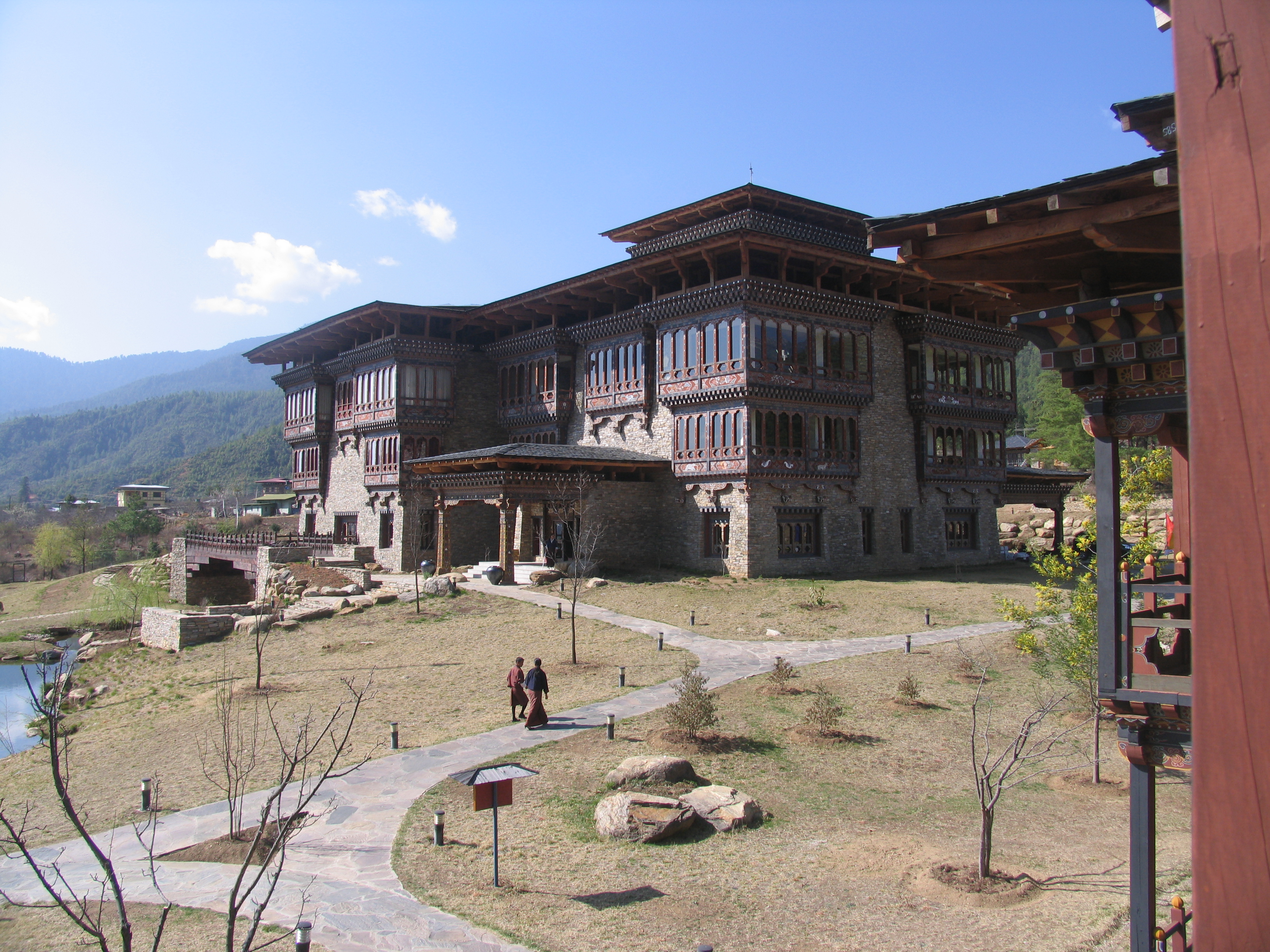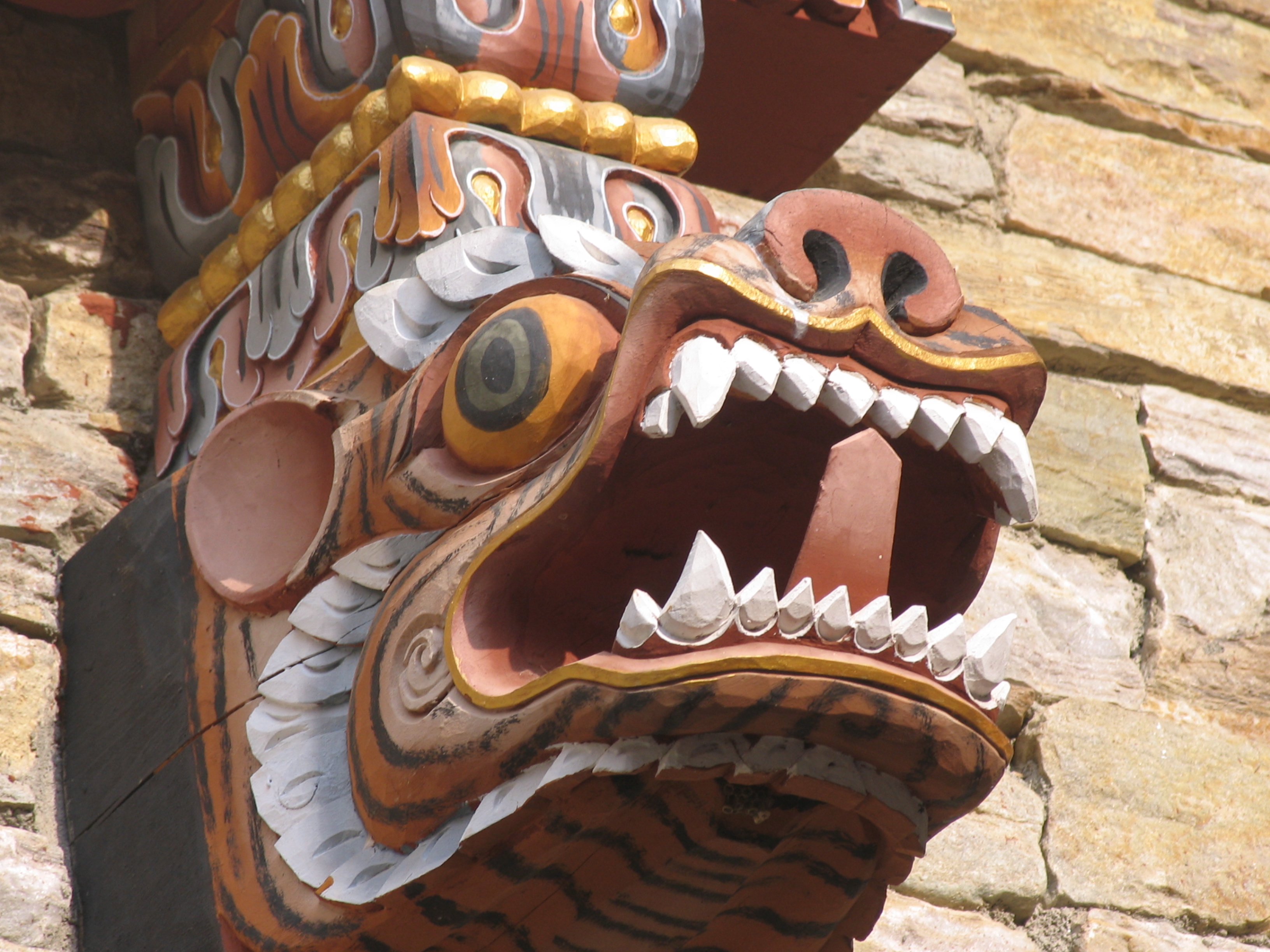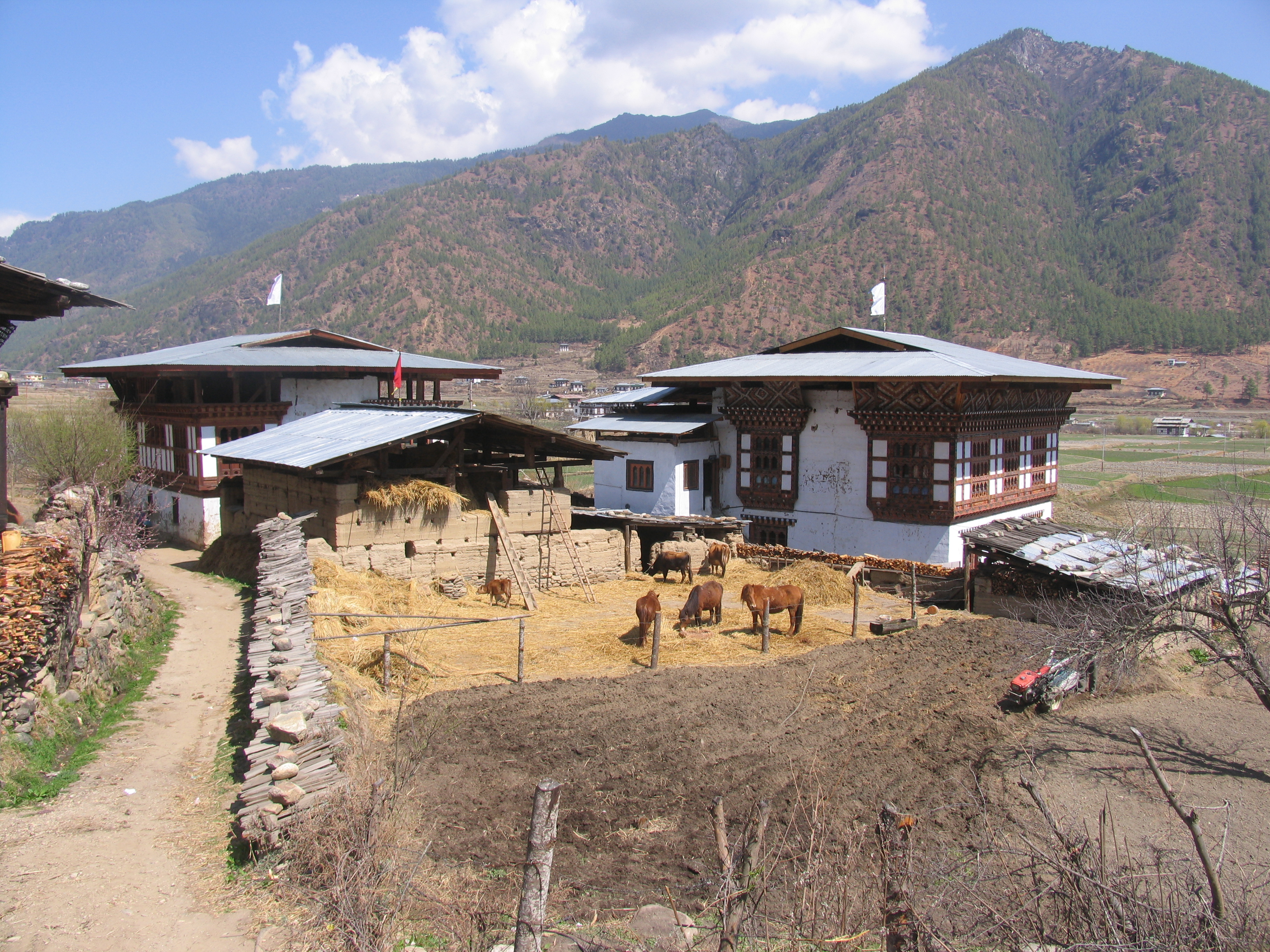

Bhutan (2008)
The Land of the Thunder Dragon
In his classical novel, Lost Horizons, James Hilton tells of four travelers who find themselves in a remote mountain valley, high in the Himalaya Mountains, called “Shangri La”. It is a land of peace and tranquility far from the troubled world. Some consider Bhutan to be the last Shangri-La, a Kingdom in the Clouds. We thought that it would be an ideal destination for celebrating our 50th year of marriage.
 |
 |
Zhiwa Ling Hotel, Paro, Bhutan Thunder Dragon (or Druk Yul) Carving
We flew into Paro, the only airport in Bhutan, on one of the only two aircraft operated by Druk Air, the Royal Bhutan Airlines, in what was surely one of the most exciting landings we have ever made. We approached Paro at dawn just as the sun was beginning to light up the snow covered peaks of the surrounding mountains. Threading our way through some of the tallest mountains in the world, which appeared almost close enough to touch, we dropped through the clouds and plunged into one of the only valleys in the country wide enough or flat enough to land a plane, descending into a mist-shrouded world with green terraces, rock-studded roofs, ancient monasteries, and a grey river snaking its way through the Paro valley. We had arrived in Bhutan, the Land of the Thunder Dragon, the last Buddhist Himalayan Kingdom in the world and the country that some claim is the mythical Shangri-La.
A country of only 700,000 people, Bhutan is the size of Switzerland: 200 miles long and 100 miles wide. It is located in the Himalaya Mountains between Tibet and India. Like Switzerland, it is surrounded by mountains which have long shielded it from the outside world. Closed off by both geography and policy, the country had no roads, cars, electricity, telephones, postal service or tourists until as recently as the 1960’s. It was a place that time forgot with its ancient temples, pristine forests, sparking rivers and high mountain peaks. It was ruled over by a benevolent monarch with four wives, all sisters.
To outsiders, it was a Shangri-La; but behind this mythical appearance, Bhutan was one of the least developed countries in the world with it people living in virtual serfdom. Its infant mortality was high and its literacy rate (30%) and its life expectancy (48 years) were low. It was a high price to pay for its thousand year history of almost total isolation.
In 1960, Bhutan’s third king, Jigme Singye Wangchuck, began to crack open the doors to the outside world, building schools, opening health clinics and constructing roads. The first (and only) road crossing the country was only completed in 1962. Prior to its completion, travelers had to detour through northern India to get from western Bhutan to eastern Bhutan. That 150 mile trip could take as much as three weeks. It now takes three days. With an average of over 40 winding curves per road mile, travel is understandably measured in days and not in miles.
The king also opened the door to limited tourism three decades ago. Few destinations have generated the stir of anticipation among travelers that Bhutan created when it cracked its door ajar in 1974. Even today, the numbers of tourists are restricted to 20,000 people per year due to limitations in hotels and facilities. Several travel agencies bill Bhutan as the premier travel destination in the world.
The challenge that the King faced was to lead the country out of its medieval past into the modern world and, at the same time, to maintain Bhutan’s unique identity. He defined the national goal as “Gross National Happiness” and focused on sustainable development, good governance, cultural preservation and environmental stewardship. Bhutan has a very enlightened environmental policy which mandates that 75% of the country remain forested with 25% of the land set aside for national parks. It allows neither commercial logging nor mountaineering.
Under the King’s leadership, the country’s economy has grown steadily over the past several decades without negatively impacting the environment. The principal source of foreign capital comes from the sale of hydroelectric power to India. The second most important source is tourism, which imposes a hefty tariff on tourists to support the nation’s infrastructure.
In 2006, the king abdicated his throne in favor of the establishment of a constitutional monarchy to be led my his 18 year old son It is one of the few times in history when a ruler has voluntarily given up his throne to turn over his power to his people. In fact, many Bhutanese were surprised by the move and still wish that their hugely popular king would retain his throne. The elections for the first parliament were held during the week of our visit and were carried out without incident. Over 80% of the population voted. One woman walked 600 kilometers to her hometown to cast her vote. It was exciting to be present at this special moment in Bhutan’s history as the country became the world’s newest democracy.
Since travel into Bhutan is restricted, tourists must enter as a part of a travel group. We chose National Geographic Expeditions. We were joined by 22 other travelers, all from the U.S. Our tour leader was Carroll Dunham, a charming woman with a sparkling smile. Carroll is medical anthropologist and practicing Buddhist, who has lived in the region for over 20 years, authored several books, runs a foundation to help Himalayan women and is a mother to six Tibetan foster children plus two of her own.. She was assisted by Tshering Dorji, our Bhutanese host, who is also a national champion in archery, Bhutan’s popular national sport. Both were delightful people and wonderful guides.
Upon arrival in Paro, we checked into the Zhiwa Ling guest house, a beautiful new lodging constructed in traditional style with elaborate hand-carved woodwork coupled with expert stone masonry. We took several long walks on the first day to get acquainted with the area and to become acclimated to the 8,000 foot altitude.
Walking through the countryside, we had an opportunity to meet and photograph some of the local families working in the rice fields and washing their clothes in a nearby stream. All were very friendly and were quick to greet us with a smile. Over 80% of the Bhutanese are subsistence farmers growing only enough to feed their own families. Their farm houses are surprisingly large, three story structures in which the ground floor houses the livestock, the middle floor the family and the top floor, which isopen to the air, provides a place to dry and store the crops.
 |
 |
Bhutanese Washer Woman Typical Bhutanese Farm House
A more strenuous walk took us to the ruins of one of the oldest dzongs in the country, built in 1647 as a defense against invaders from Tibet. A dzong is a classical and uniquely Bhutanese structure built on a grand scale in each town or region without the help of any drawings or nails. Traditional patterns of rich colors adorn every wall, beam, pillar and door. The architecture is massive in style with sloping exterior walls surrounding a complex of courtyards, temples, administrative offices, and living quarters for the monks. Dzongs serve as the religious, military, administrative, and social centers of their district. They are often the site of an annual tsechu or religious festival.
The following day we rose early and hiked up to the Paro Dzong to witness the opening day of the five day Paro Tsechu (or festival), the country’s largest Buddhist festival of the year, featuring costumed dancers performing masked dance-dramas in the inner courtyard of the fortress. The festival celebrates events in the life of Guru Rimpoche, who introduced Buddhism to Bhutan in the 8th century. Since the Chinese government has outlawed this celebration in Tibet, the Paro Tsechu is now the largest Buddhist festival of its kind in the Himalayas.
The tsechu is a fundamentally religious festival. By their attendance, the people gain merit. Its western counterpart might be the old European morality plays of the Middle Ages. The festival is enthusiastically attended by the local people, who come attired in their finest clothing and jewelry. Mingling with the locals in this joyous celebration, a highlight of their social calendar, was a great thrill which only a limited number of visitors each year can experience.
 |
 |
Young Monks Watching the Religious Festival (Tsechu) Masked Dancers Performing at Paro Tsechu
The Bhutanese are not only a handsome people; they are also some of the happiest and most friendly people that we’ve met in our travels. Most of them wore their national garb, mandated by the King as a means of maintaining their national identity and traditions. The men wear a gho, a beautiful knee length robe-like garment that is held in place by a woven belt or kera, with knee socks and wingtip shoes. Women wear a long floor-length skirt called a kira that is typically hand woven in bright colors. Children were also decked out in their finest clothes. Many of the children were anxious to talk to us in English, which has been designated as the national language.
The performances were held in the courtyard of the dzong. The three tiers of balconies were lined with monks and young novices, who looked down on the dancers’ movements with great attention to their religious significance. The head lama was seated in a central box and presided over the event. The few Western tourists in attendance were crowded around the edges of the ground floor vying for positions to take photographs of the colorful event.
Unfortunately, it was at the festival that Val experienced severe fatigue and distress from the higher elevations and we had to cut our trip short to fly out the next day to Bangkok for medical attention. Fortunately, the problem was not a serious one.
Although we were disappointed to miss out on the remainder of our itinerary in Bhutan – the remote villages, the high valleys surrounded by towering mountains and sleeping under the stars in a tented camp – we did, at least have a brief glimpse of this fascinating country and enough time to come to appreciate its wonderful people and their unique culture. Without doubt we had found Shangri-La, the mythical land of love, happiness and tranquility.
Since we will be celebrating our 50th wedding anniversary later in the year, perhaps, Shangri-La is also a metaphor for our own 50 years of marital bliss